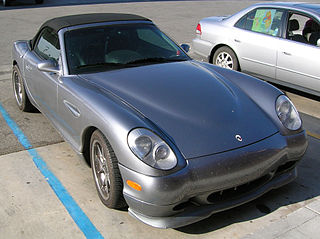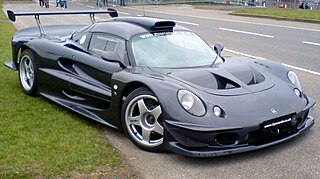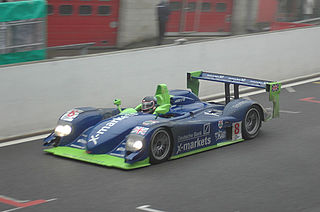
Sports car racing is a form of motorsport road racing which utilises sports cars that have two seats and enclosed wheels. They may be purpose-built prototypes or grand tourers based on road-going models. Sports car racing is one of the main types of circuit auto racing, alongside open-wheel racing, touring car racing and stock car racing. Sports car races are often, though not always, endurance races that are run over particularly long distances or large amounts of time, resulting in a larger emphasis on the reliability and efficiency of the car and its drivers as opposed to outright car performance or driver skills. The FIA World Endurance Championship is an example of one of the best known sports car racing series.

The Esperante is a sports car made by Panoz, an American car manufacturer.

Panoz is an American manufacturer of luxury sports automobiles founded in 1989 as Panoz Auto Development by Dan Panoz, son of Don Panoz. The company has also been extensively involved in professional racing, and designs, engineers and builds its own race cars. Panoz products have included the Panoz Roadster and AIV Roadster, the Panoz Esperante, and the Panoz Avezzano.

A Le Mans Prototype (LMP) is a type of sports prototype race car used in various races and championships, including the 24 Hours of Le Mans, FIA World Endurance Championship, IMSA SportsCar Championship, European Le Mans Series and Asian Le Mans Series. Le Mans Prototypes were created by the Automobile Club de l'Ouest (ACO). The technical requirements for an LMP include bodywork covering all mechanical elements of the car. As of 2023, there are two classes within Le Mans Prototypes, designated LMP2 and LMP3.

The 1998 24 Hours of Le Mans was the 66th Grand Prix of Endurance, and took place on 6 and 7 June 1998.

The Toyota GT-One is a racing car initially developed for Group GT1 rules, but later adapted into an LMGTP car. It raced in the 1998 and 1999 24 Hours of Le Mans.

Dirk Müller is a German Ford factory racing driver, driving for Ford Chip Ganassi Racing in the 2016 IMSA WeatherTech SportsCar Championship. His former Schnitzer BMW team-mate Jörg Müller is unrelated, as is French driver Yvan Muller.

Marc Lieb is a former German Porsche factory motor-racing driver. He won the FIA GT Championship in 2003 and 2005, and the European Le Mans Series in 2005, 2006, 2009 and 2010. He won the 24 Hours Nürburgring four times, one time the 24 Hours of Le Mans in 2016, in the 2008 12 Hours of Sebring, in the 2003 24 hours of Spa and in the 2007 Petit Le Mans. He is also the 2016 FIA World Endurance Champion.

The McLaren F1 GTR is the racing variant of the McLaren F1 sports car first produced in 1995 for grand touring style racing, such as the BPR Global GT Series, FIA GT Championship, JGTC, and British GT Championship. It was powered by the naturally aspirated BMW S70/2 V12 engine. It is most famous for its overall victory at the 1995 24 Hours of Le Mans where it won against faster purpose-built prototypes in very wet conditions. The F1 GTR raced internationally until 2005 when the final race chassis was retired.
David Price Racing was a British motor racing team, founded by David Price. The team competed in various forms of motorsport from their foundation in 1976 until 2008. The team was sold in April 2009, but continued racing in GP2 and GP2 Asia Series under the name David Price Racing until 2010.

The Lotus Elise GT1 is a race car developed for grand tourer-style sports car racing starting in 1997.

Élan Motorsport Technologies is an American enterprise that serves as an umbrella company containing the race car engineering, development and manufacturing companies owned by American racing and automotive company conglomerate Panoz Motor Sports Group. Élan engineers, designs and builds Panoz-branded race cars and components. Since its founding it has also acquired several manufacturers, including famous Formula Ford builders Van Diemen and IndyCar Series constructor G-Force. Élan-built cars have successfully competed in the American Le Mans Series, Le Mans Series, IMSA Prototype Lites and various other championships, racing series and types of professional racing throughout the world. It designs, develops and manufactures full line race cars, i.e. chassis, bodies, components and engines for professional racing competition for a variety of segments and classes.

Marino Alessandro Cesare Franchitti is a British racing driver, and the younger brother of Dario Franchitti. He has spent the majority of his career racing in sports cars and grand tourers, with a career highlight of winning the 2014 12 Hours of Sebring.

The Dallara SP1, also known as the Chrysler LMP, was a Le Mans Prototype built by Italian firm Dallara. Initially used as part of Chrysler Corporation's attempt to win the 24 Hours of Le Mans, the cars were later sold to customers for use series such as the FIA Sportscar Championship and Le Mans Series.

The Cadillac Northstar LMP was a series of Le Mans Prototypes built by Cadillac for use in the American Le Mans Series as well as an attempt to return Cadillac to the 24 Hours of Le Mans since they first entered in 1950. The Northstar LMPs were named after the Northstar V8 engines which powered them. The Cadillac project ran from 2000 until 2002 when General Motors decided to cancel the project to concentrate solely on their Chevrolet Corvette program. Cadillac returned to prototype racing in 2017 with the Cadillac DPi-V.R in the WeatherTech SportsCar Championship.

The Lola B98/10 was a Le Mans Prototype built by Lola Cars International for use in the International Sports Racing Series, American Le Mans Series, and 24 Hours of Le Mans. It would be the first international sports car built by Lola since they briefly left the sport in 1992 following the Lola T92/10. It would be succeeded in 2000 by the Lola B2K/10.

The Panoz LMP-1 Roadster-S was a Le Mans Prototype built for Panoz in 1999. The car was a successor to the Esperante GTR-1 which had competed in the Grand Tourer categories internationally. Following competition in the American Le Mans Series and at the 24 Hours of Le Mans until 2001, the car was replaced by the Panoz LMP07.
The Panoz LMP07 was a Le Mans prototype built in late 2000 for Panoz for competition in the American Le Mans Series. The car was designed as a successor to the Panoz LMP-1 Roadster-S which had competed since 1999. Although retaining the unusual format of having the engine in front of the cockpit, the LMP07 was quickly found to be lacking the capabilities of its predecessor, forcing Panoz to abandon it and return to the LMP-1 Roadster-S. The LMP07 would survive in the hands of privateers until 2003.

The Riley & Scott Mark III was a sports prototype auto racing car developed by Bob Riley, Bill Riley and Mark Scott of Riley & Scott Cars Inc. Initially designed in 1993, the car was created for the World Sports Car (WSC) category which was to debut in the North American IMSA GT Championship during their 1994 season. It was not until 1995 that the first Mk III was completed, but the construction of further cars allowed a variety of teams to campaign in several North American and European racing series, including competing at the 24 Hours of Le Mans.
The 2012 American Le Mans Series season was a multi-event auto racing championship for sports racing cars which conform to the technical regulations laid out by the International Motor Sports Association for the American Le Mans Series. It was the fourteenth season of the American Le Mans Series, and the 42nd season overall of the IMSA GT Championship. The season began with the 60th annual 12 Hours of Sebring on March 14–17, and covered ten events.



















